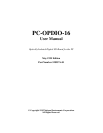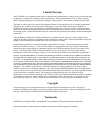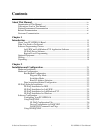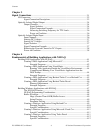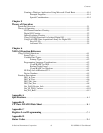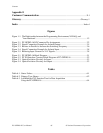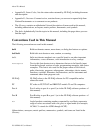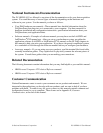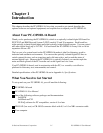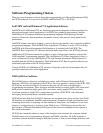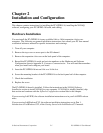© National Instruments Corporation ix PC-OPDIO-16 User Manual
About This Manual
____________________________________________________
This manual describes the electrical and mechanical aspects of the PC-OPDIO-16 and contains
information concerning its installation, operation, and programming. The PC-OPDIO-16 is fully
compatible with industry standard Intel-Microsoft Plug and Play specification Version 1.0a.
The PC-OPDIO-16 is an optically isolated digital I/O board for PC/XT/AT and IBM Personal
System 2 (PS/2) models 25 and 30 computers. This board is designed for low-cost data
acquisition and control for applications in laboratory testing, production testing, and industrial
process monitoring and control.
Organization of This Manual
The PC-OPDIO-16 User Manual is organized as follows:
• Chapter 1, Introduction, describes the PC-OPDIO-16; lists what you need to get started;
describes the optional software and optional equipment; and explains how to unpack your
PC-OPDIO-16.
• Chapter 2, Installation and Configuration, contains instructions for installing the
PC-OPDIO-16, installing the NI-DAQ software, configuring your PC-OPDIO-16 board, and
cabling.
• Chapter 3, Signal Connections, describes the pin arrangement, signal names, and signal
connections on the PC-OPDIO-16.
• Chapter 4, Fundamentals of Building Applications with NI-DAQ, contains general
information about building NI-DAQ applications that run in DOS and Windows and explains
the nature of the files needed and the basics of making applications. You can skip this
chapter if you are an experienced NI-DAQ user.
• Chapter 5, Theory of Operation, describes the theory of operation for optically isolated
digital I/O on the PC-OPDIO-16. This chapter also discusses using NI-DAQ functions with
the PC-OPDIO-16 board.
• Chapter 6, NI-DAQ Function Reference, contains important information about how to apply
the NI-DAQ function descriptions in this manual to your programming language and
environment. This chapter also includes a detailed description of each NI-DAQ function that
supports the PC-OPDIO-16. You can skip this chapter if you are an experienced NI-DAQ
user.
• Appendix A, Specifications, lists the specifications of the PC-OPDIO-16.
• Appendix B, LDA210 Data Sheet, contains a manufacturer data sheet for the LDA210 solid
state current sensor (CP Clare Corporation). This sensor is used on the PC-OPDIO-16
isolated input port.
• Appendix C, Register-Level Programming, describes in detail the address and function of
each PC-OPDIO-16 register.



